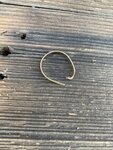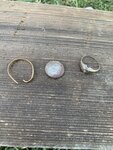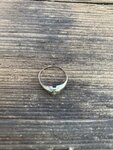Ronstar
Well-known member
Ok, still hunting the yellow gold. Hell even the white gold would suffice.......
I have the broken 14k band I stumbled on 6-7 yrs ago. I was actually going after a dime signal when I saw a goldish colored wire sticking out of the thatch layer in the park lawn. It turned out to be a gold band that most likely was sucked up and cut by the lawn mowers. Not anything I would display but obviously kept it.
I remembered I had it and thought it prudent to pull it out as a test target as needed. I’ve never actually tried it until recently and then stumped when the F5 and a Minelab Etrac failed to detect it. All either of us could get was jumpy numbers and no clear hit. By jumpy numbers I mean from low foil to high zinc and nothing repeatable twice.
Today I set up a test. I have an older white gold ring with a diamond and very thin band except where the setting is located. Both rings were taken outside and put on an old cedar shingle. I tested the ground for interference and nothing sounded off. Turned off F5 and restarted. Set gain at 50 and threshold at 0. Performed ground balance and both sides settles at 60-62, normal for here. Set gain to 75 and left TH at 0. On the board was the gold band, then 12” to a clad dime, then 12” to the white gold. Failure to detect the gold band, solid 72 on the dime, and 18-19 on the white gold. I was using the 11” DD factory coil.
Switched to the 5” round coil. Failure on the gold band, 74 on the dime, 19-20 on the white gold. I also tried TH from -9 to +9 with no difference. Height on swing was 2-4”.
The gold band measured 0.125 width (or 3.1 mm) and weighs 1.8 grams. I have not weighed the white gold but band under the finger is extremely thin. Both rings are stamped 14k. Both rings not magnetic.
Does the fact the gold ring is not round play any part? Anybody have any ideas why the gold band is not detectable?
I have the broken 14k band I stumbled on 6-7 yrs ago. I was actually going after a dime signal when I saw a goldish colored wire sticking out of the thatch layer in the park lawn. It turned out to be a gold band that most likely was sucked up and cut by the lawn mowers. Not anything I would display but obviously kept it.
I remembered I had it and thought it prudent to pull it out as a test target as needed. I’ve never actually tried it until recently and then stumped when the F5 and a Minelab Etrac failed to detect it. All either of us could get was jumpy numbers and no clear hit. By jumpy numbers I mean from low foil to high zinc and nothing repeatable twice.
Today I set up a test. I have an older white gold ring with a diamond and very thin band except where the setting is located. Both rings were taken outside and put on an old cedar shingle. I tested the ground for interference and nothing sounded off. Turned off F5 and restarted. Set gain at 50 and threshold at 0. Performed ground balance and both sides settles at 60-62, normal for here. Set gain to 75 and left TH at 0. On the board was the gold band, then 12” to a clad dime, then 12” to the white gold. Failure to detect the gold band, solid 72 on the dime, and 18-19 on the white gold. I was using the 11” DD factory coil.
Switched to the 5” round coil. Failure on the gold band, 74 on the dime, 19-20 on the white gold. I also tried TH from -9 to +9 with no difference. Height on swing was 2-4”.
The gold band measured 0.125 width (or 3.1 mm) and weighs 1.8 grams. I have not weighed the white gold but band under the finger is extremely thin. Both rings are stamped 14k. Both rings not magnetic.
Does the fact the gold ring is not round play any part? Anybody have any ideas why the gold band is not detectable?




